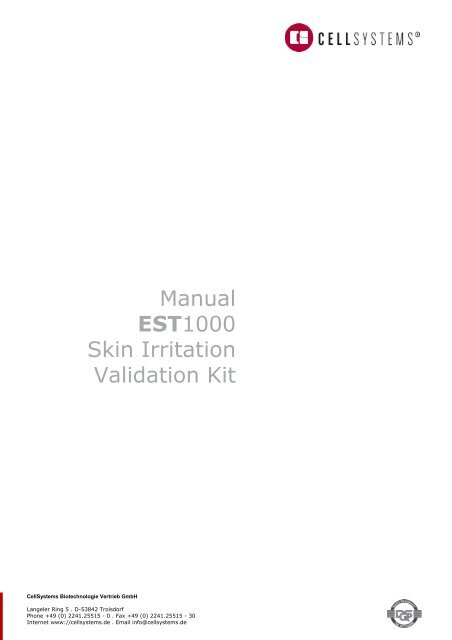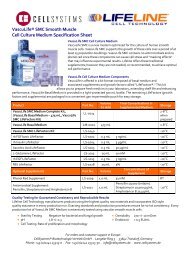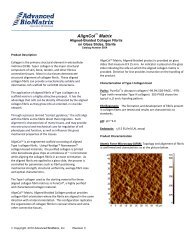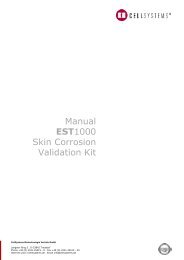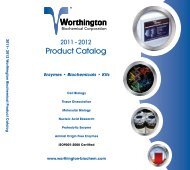Manual EST1000 Skin Irritation Validation Kit - CellSystems ...
Manual EST1000 Skin Irritation Validation Kit - CellSystems ...
Manual EST1000 Skin Irritation Validation Kit - CellSystems ...
Create successful ePaper yourself
Turn your PDF publications into a flip-book with our unique Google optimized e-Paper software.
<strong>Manual</strong><strong>EST1000</strong><strong>Skin</strong> <strong>Irritation</strong><strong>Validation</strong> <strong>Kit</strong><strong>CellSystems</strong> Biotechnologie Vertrieb GmbHLangeler Ring 5 . D-53842 TroisdorfPhone +49 (0) 2241.25515 - 0 . Fax +49 (0) 2241.25515 - 30Internet www://cellsystems.de . Email info@cellsystems.de
1. IntroductionDue to legal restrictions for animal testing, three dimensional in vitro models areincreasingly used to measure effects of skin-active substances.For routine skin irritation testing <strong>CellSystems</strong> ® provides the epidermis model <strong>EST1000</strong>.The cellular structure of <strong>EST1000</strong> resembles that of natural epidermis showing a basemembrane, proliferating keratinocytes and stratum corneum with an intact barrierfunction. It shows an excellent in vitro / in vivo comparison and allows a highreproducibility of results.One major parameter to evaluate the skin irritation potential of a given substance is theviability of the treated skin equivalents before and after exposure to the test substances.A compound is classified as irritant if the cell viability is reduced below 50 % after 20min of exposure followed by washing off the substance and a 42 hrs incubation period.For statistical relevance, compound and control testing should be carried out intriplicates.According to the definition of skin irritation, skin models are incubated with 30μl of thecompounds for 20 min. It is crucial to evenly apply the compound on the surface of<strong>EST1000</strong>. After the indicated time the models are rinsed thoroughly and are incubatedfor another 42 hrs before viability measurement.Finally, cell viability is measured by performing a standard MTT assay. Metabolicallyactive cells reduce the yellow tetrazolium salt MTT (3-[4,5–dimethylthiazol-2-yl]–2,5–diphenyltetrazolium bromide) to insoluble purple formazan crystals. The addition ofisopropanol dissolves the crystals and the change in colour can be quantified bystandard absorbance measurement. The relation between the absorbance values of thetreated model and of the control model defines the rate of cell survival.The validation kit is designed to confirm inter-laboratory reproducibility and to gainreliable results in your laboratory. It consists of 2 x 9 epidermis models of the same lot.The irritative potential of two blinded test substances is determined in parallel at yourfacility and at <strong>CellSystems</strong> ® ISO certified laboratories in Germany. After successfulperforming this validation assay you will be certified. This certificate will prove yourexpertise in the use of <strong>EST1000</strong> for skin irritation testing.<strong>CellSystems</strong> ® laboratory facility has implemented the Quality-Management-System andis certified according to DIN ISO 9001:2008, register number: 266714 QM08.<strong>EST1000</strong> <strong>Irritation</strong> <strong>Validation</strong> V1.4b eu 1
2. <strong>Kit</strong> ContentsOne half of the material will be delivered to your laboratory; one half will be delivered tothe <strong>CellSystems</strong>´ R&D department for parallel testing.You receive:• 9 human skin equivalents in 24 well plates,embedded in transport medium• 50 ml Maintenance Medium• 20 mg MTT-Reagent• 20 ml MTT-Assay Medium (enough medium to prepare a 1 mg/ml MTT solution asspecified on the label)• Test Item A• Test Item B• Negative Control (PBS)• 9 sterile meshes• 4x 6-well plates• 1x 24-well plate• 1x 96-well plateNoteThe test items purchased are toxic and irritative. Please, be careful while handling thesecompounds and establish suitable security precautions for your own safety.<strong>EST1000</strong> <strong>Irritation</strong> <strong>Validation</strong> V1.4b eu 2
3. Additional Required Materials• Class II biological safety cabinet• Incubator (37 °C, 5 % CO 2 , 95 % humidity)• Water bath (37 °C)• Vertical shaker• 96-well plate reader spectrophotometer• Micro-Pipettor (sterile)• Pipette tips (sterile)• Pair of tweezers (sterile)• Squeeze bottle• 250 ml beaker• 1 x PBS (Phosphate buffered saline), sterile• Isopropanol<strong>EST1000</strong> <strong>Irritation</strong> <strong>Validation</strong> V1.4b eu 3
4. InstructionsPreparation on receiptImmediately upon receipt check the kit for completeness and possible transportdamages. Read the instructions completely and carefully before handling the skinmodels as described below:• Please, inform <strong>CellSystems</strong> ® when the package has arrived and you are going tobegin with experimentation to ensure the same conditions for the parallel testing.You can either call +49 (0)2241 25515-0or send a fax to +49 (0)2241 25515-30• The culture dishes with the cooled skin equivalents are in the inner transport box.• Set up the culture dishes (2 x 6-well) and pipette 1000 μl cold maintenance medium(4 °C to 8 °C) into nine wells.• Remove the Parafilm TM from the transport plate with the skin equivalents and openthe culture dish under sterile conditions.• Lift the inserts - containing the models - with a sterile pair of tweezers and transferthem into the prepared 6-well plates filled with maintenance medium. Make surenot to transfer any agarose.• Avoid bubbles between the insert and the bottom of the culture dish by settingobliquely the insert into the culture dish.• Incubate the culture dishes at least 2 hours at 37 °C, 5 % CO 2 , 95 % humidity beforeperforming first experiments. It is also possible to incubate overnight. In this case it isrecommended to change medium before applying the test substances.• After this adaptation-phase, your test substances can be applied onto the stratumcorneum.<strong>EST1000</strong> <strong>Irritation</strong> <strong>Validation</strong> V1.4b eu 4
5. Protocol5.1 Application of test samples (under sterile conditions)• Apply 30 μl each of test item A, test item B and PBS topically to the centre of theskin equivalents by using a sterile micropipette. It is crucial to evenly apply thecompound on the surface of <strong>EST1000</strong>.Cover each model with a sterile mesh.For each substance three models are required.• Cultivate the models at room temperature for 20 min.• Prepare 9 wells of the 6-well plates with 1 ml fresh pre-warmed maintenancemedium.• Pick up each insert with tweezers. Remove the mesh from the skin model. Removethe test substance by rinsing the tissue gently with 1x PBS (20 times) using a squeezebottle. Remove excess PBS by gently shaking the insert and blotting the bottom witha piece of paper towel.• Transfer the models into the wells containing 1 ml fresh pre warmed medium andincubate the models for 42 hrs (37 °C, 5 % CO 2, 95 % humidity).5.2 Addition of MTT• Prepare a 1.0 mg/ml solution of MTT in MTT-Assay Medium and add 300 μl of theMTT medium to 9 wells of a new 24-well plate.• Transfer the models quickly into one well each of the prepared 24-well plate withthe MTT-Assay Reagent.• Incubate the 24-well plate for 3 hrs (37 °C, 5 % CO 2 , 95 % humidity).<strong>EST1000</strong> <strong>Irritation</strong> <strong>Validation</strong> V1.4b eu 5
5.3 Extraction of the formazan crystals• Pick up the insert with tweezers.• Remove excess MTT-Assay Reagent by blotting the bottom with a piece of papertowel.• Transfer the models to a new 24-well plate.• Add 2 ml of isopropanol directly to each model. The model in the well should besubmerged completely.• Shake the plate for 2 hours at RT on a vertical shaker or store at 2 – 8 °C overnight.• Puncture the membrane of the model with a pipette tip and remove the model tocombine the isopropanol extraction of each well.• Shake carefully on a vertical shaker for about 10 min.• Dispense duplicates of 200 μl of each sample dilution to an appropriate well of a 96-well flat bottom plate.• Using a 96-well plate reader spectrophotometer read the absorbance at540 – 570 nm using acidified isopropanol as a blank.• If necessary dilute the sample extract 1:3 to 1:5 in isopropanol and repeat thephotometric measurement.• Viability is calculated as follows:viability (%) = (absorbance test substance / absorbance control) x 100<strong>EST1000</strong> <strong>Irritation</strong> <strong>Validation</strong> V1.4b eu 6
6. Result ProtocolPlease, send a copy of this protocol to <strong>CellSystems</strong> ®Fax: +49 (0)2241 25515-30Date:Model: <strong>EST1000</strong> (Epidermal <strong>Skin</strong> Test 1000)Lot No.:Assay: <strong>Skin</strong> <strong>Irritation</strong> StudyExperimentator:Method: <strong>EST1000</strong> <strong>Skin</strong> <strong>Irritation</strong> <strong>Validation</strong> <strong>Kit</strong> <strong>Manual</strong>Device Verification:CO 25% ±0.5Incubator Water bath Micro-PipettesTemp37°C± 1Water reservoircheckTemp37°C± 11 ml H 2 Oweight1.: 1.:50 μl H 2 Oweight2.: 2.:3.: 3.:MeanSDCV %You may also provide a certificate of pipette calibration!Quality Evaluation:RemarksMacroscopicMicroscopicother<strong>EST1000</strong> <strong>Irritation</strong> <strong>Validation</strong> V1.4b eu 7
Schedule:Date20 min exposure to testcompound incl. appl. +washingPostincubation 42 hrsMTT-AssaymediumincubationFormazanextractionStart Stop Start Stop Start Stop Start StopResults:MeanOD 550nmCompound A20 minCompound B20 minPBS20 minModel 1Model 2Model 3MeanViabilityCompound A20 minCompound B20 minPBS20 minModel 1Model 2Model 3Summarizing remarks:<strong>EST1000</strong> <strong>Irritation</strong> <strong>Validation</strong> V1.4b eu 8


